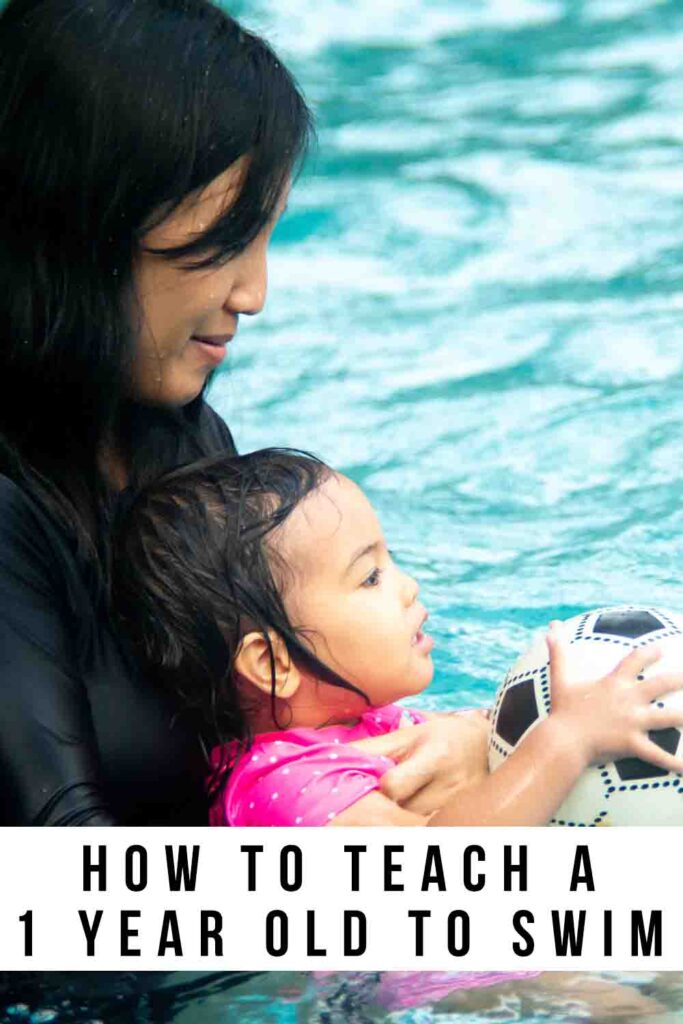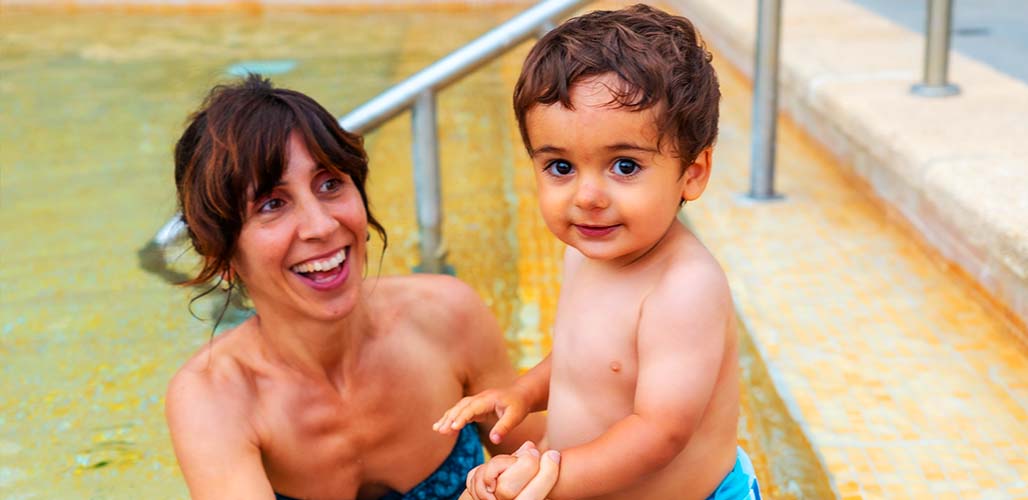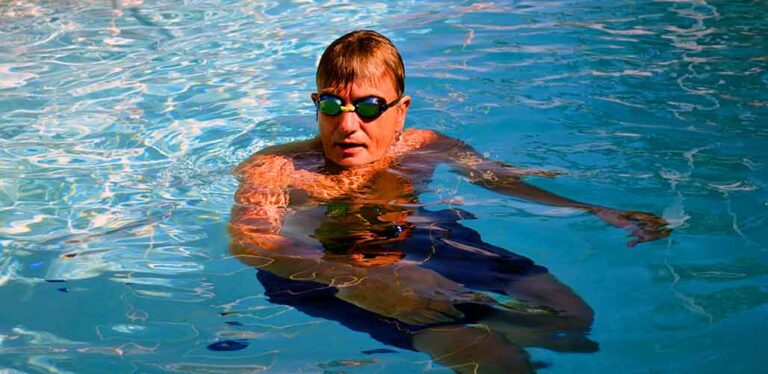How To Teach A One Year Old To Swim
In this article, we will explore techniques for how to teach a one year old to swim that I have learned as a swim instructor. We will begin by gently introducing them to the water and the sensation of getting their faces wet. We will work our way towards what I call a ‘big swim’, when their face is submerged in the water. And by the end, you will be equipped with the foundational techniques needed for independent swimming in future.
Contents
How To Teach A One Year Old To Swim
Most parents want to teach their kids to swim in order to keep them safe, and so that they can enjoy swimming or other water activities together when they’re older. Basic water safety skills include more than just knowing how to swim, however. Knowing how to enter water safely, float or tread water, orientate themselves to face an exit, and climb back out are all equally important. Until you’re child is much older, teaching them them the basics of swimming is no substitute for supervising them in the water. But it is a fun way to introduce your toddler to the pool, and bond over a shared activity. So in this article, we’re going to focus with the foundational steps of swimming itself. Let’s begin!
First Encounters
Before they can swim, you want to ensure that your child is comfortable being in water. Pick a small, warm body of water like the bathtub that your child feels safe in. Encourage your child to play with water toys, splash, and experience the sensation of the water on their skin.

Once they are comfortable, use a cup and begin gently pouring water over their shoulders and back. Slowly move the cup above their heads and allow the water to rain down over their face. Repeat this process until the child is totally comfortable with it. An important technique to implement in these early stages is the use of a priming phrase. Before you pour the water, use a phrase such as ‘[Child’s name], ready, go!’. This will prime them to expect the water and close their eyes whenever they hear the phrase. Instinctively, their airways will also close.
Entering The Pool
Next you will need to find a pool. Bring a cup, and any water toys your child enjoys. This is a new environment for them, and we want to ensure that they feel safe and comfortable.
Hold your child securely and enter the pool in the shallow area. Allow them to adjust to the feeling of being held as you move them through the water. Once they seem comfortable, you can begin using the priming phrase followed by the cup to get their hair and face wet.
Singing songs and playing games can be especially useful at this stage. If your pool has an extra-shallow area they can walk or toddle in, spread some toys around and encourage them to clean up the toys. Games like this help children view the pool as a safe, friendly environment.
Big Swims
Now that they’re comfortable in the water, your child is ready to submerge their face and complete their first big swim. During a big swim, we want to make sure that your child does not swallow any water. To do this, you’ll repeat your priming phrase, and lightly tap their lips on the surface of the water before submerging them. This will prompt them to instinctively close their eyes and mouth.
- Hold your child in the prone position (face and belly down, in your arms) as you slowly walk through the water.
- Begin to say your priming phrase, ‘[Child’s name], ready, go!’
- Once you say ‘go’, tap their lips on the water and then lower them down until their entire face is submerged.
- Walk slowly through the water as you hold them in this position for one or two seconds.
- Lift them back up, and praise them for their big swim!
Congratulations! You just accomplished a major step in teaching your child to swim. As you continue to play in the water, keep helping your child with big swims to get them really used to the sensation of being submerged. Take your time during this stage in the process, as the next step towards independent swimming requires that your child is relaxed and comfortable during a big swim.
Safety notes
- Make sure your child is horizontal, so water doesn’t get pushed up their nose.
- Move slowly and gently – pushing them quickly through the water will force their head back, which is distressing for them, and also likely to result in them inhaling or swallowing water.
- Don’t attempt a big swim with a one year old who is tense or stressed.
Further Skills For Independent Swimming
In my years of working as a swim instructor, I have developed several techniques to help children complete an independent big swim. The three major skills that we want to develop in your child are:
- Blowing bubbles
- Kicking
- Paddling with their arms
Blowing bubbles
Most kids around one year of age are excellent at replicating what they see. We can use this to our advantage in developing these skills. Show your child how you can blow out your air and lower your mouth into the water to create bubbles. Try using your bubbles to blow a toy towards the child and encourage them to blow it back. Blowing bubbles will be a very important skill when your child is eventually learning to take a breath.
Kicking
I have found that kicking comes very naturally to children, and generally does not take long for them to pick up. First, hold your child so you can manipulate their legs. Move their legs up and down so they get a feel for the kicking motion. Next, it’s time for a big swim, but while your child’s face is in the water, you are going to rock their hips from side to side which will encourage them to kick their legs.
Arm paddles
Arm paddles can be taught in a very similar way. First, with the child sitting on your knee, move the child’s arms in a windmill motion so they can feel the movement. If your child is having trouble moving their arms, try physically moving their arms in the windmill motion while supporting them above the water. Then once again, it is time for a big swim during which you will rock the child from side to side, but doing so in a way that encourages them to move their arms out of the water.
Swimming Independently
Once your child seems to be utilizing these skills during their big swims, try sending them independently to either the wall or ideally, to another adult or parent. After you put their face in for a big swim, give them momentum and release them in the direction you want them to swim. During this independent big swim, the hope is that they will kick, blow bubbles, and use their arms.
How To Teach A One Year Old To Swim – Summary
I hope you’ve enjoyed this simple introduction to how to teach a one year old to swim. Before we even think about the action of swimming, it’s important to make sure one year olds are comfortable in the water, and relaxed about having their face submerged. If you missed it, there’s a video near the top of the page showing how an experienced swimming teacher coaches their one year old basic through the first steps of learning to swim. And remember – when it comes to safety, there is no substitute for supervision!
Let us know how your one year old is getting on in the pool, using the comments box down below.


